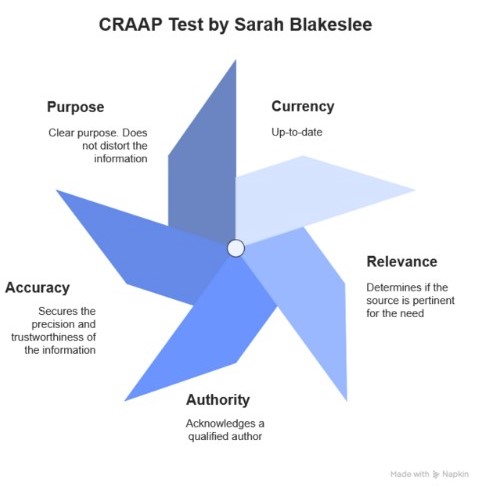Key points
There are many ways to evaluate information, but one of the most common and trusted by librarians is the well known
CRAAP test.
-
CRAAP stands for:
-
Currency - recent sources that aren't dated
-
Relevance - how relevant to your search needs are the results
-
Authority - is the material written by an expert in the topic
-
Accuracy - Secures the precision and trustworthines of the information
-
Purpose - why was it written? is the material academic or perhaps biased or marketing?
- You can apply these points of the CRAP test to a source to make sure it passes, and therefore if it should be used.
Sometimes the slightly different acronym CRAAP is used. This version, with an extra A, stands for Currency, Relevance, Authority, Accuracy, and Purpose.

- Currency:
- How recently was the information created/written?
- Unless you are doing historical research, you should try to find the most recent material possible. Exact recency may differ depending on the topic
- Is it current enough for your topic? How much does this matter within your subject? A subject like Wills Law may not change much, but research on Artificial Intelligence is something that changes very quickly and even a year old material may be out of date. Your lecturer, supervisor or Tutor will tell you how old is too old for the topic area.
- Relevancy:
- Sources sometimes may look good, by may not be exactly relevant to your question
- Does the source frequently mention your topic? May be it is only mentioned tangentially.
- Can you understand it? If its too complex, you may need to find material written on the topic in a better way.
- Authority:
- Who wrote this? Are they an academic from a respected instution?
- What makes them an expert? Check their qualifications, or are they respected in their community? Try googling them to find out.
- Is it a scholarly source? Has the source been peer reviewed? Is published in a reputable journal?
- Purpose:
- For what purpose was it written? Was it an academic purpose?
- If its on a website, try to see what the aim of the website or the article is - this may indicate the work was written for some other reason, for pushing a particular biased view for example, which may mean the article is not trustworthy.

